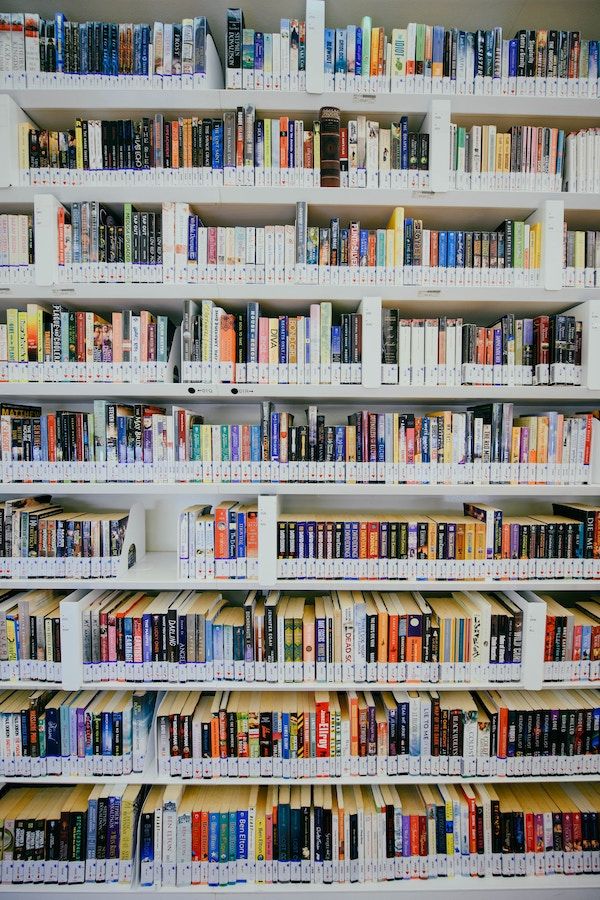How to Find a Book in the Library When You Have a Book in Mind
It’s important to note that all libraries are different. Even within a single public library system, for example, there can be sizable differences in how someone might find the same book. That means, anything from here on out is a generalization and if you’re ever unsure about something in the library, the key is to talk to the staff—that’s what we’re here for! However, in general, most public libraries in the United States use what’s called the Dewey Decimal System (formally Dewey Decimal Classification). Although the System is set up to include both fiction and nonfiction, public libraries typically use it just for nonfiction (which, confusingly, often includes “literature”—more on that in a minute). The Dewey Decimal System, which first appeared in 1867, is riddled with flaws and outdated, but many libraries still employ it today. Made up of ten categories defined by whole three-digit numbers starting with 000 and ending with 999, the System allows books to be categorized by increasingly granular detail, indicated by—surprise!—decimal digits. These digits, when listed on a book (usually called a “spine label” as it will be a sticker placed on the spine of a book) are called “call numbers” and help to identify the content of a book and where the book will be located physically relative to other books. Nonfiction books in a Dewey Decimal library are shelved numerically according to their call number from lowest to highest. (One exception that seems somewhat common is that some libraries will extract biographies, which fall at 92, and place them at the end of the collection after 999.999 or elsewhere, for ease of browsing for customers and other reasons.) So, for example, if you wanted a book on Rockingham County in New Hampshire, you would start with books in the 900s for History, Geography, and Auxiliary Disciplines. Then, you’d go to the 970s, where you would find History, Geography, and Auxiliary Disciplines: General History of North America. Next, you would further narrow your search to the 974s, which details History, Geography, and Auxiliary Disciplines: General History of North America: Northeastern United States. Next (yes, there’s more!), you’d move to the decimal points and find 974.2s, which houses all things History, Geography, and Auxiliary Disciplines: General History of North America: Northeastern United States: New Hampshire. And, finally, 974.26 will take you specifically to History, Geography, and Auxiliary Disciplines: General History of North America: Northeastern United States: New Hampshire: Rockingham County. Cool, right? You can find a summary of all Dewey Decimal Classification categories here, to whole numbers. You might find some surprising categories in the list and perhaps some new interests. (Meanwhile, if you see someone with a 398.2 tattoo or piece of jewelry, it’s a good chance they’re into fairies and fairytales.) With this list, you can start to narrow down your treasure hunt for a nonfiction book in a library that uses Dewey Decimal. But what about libraries that don’t use the Dewey Decimal System? Great question! Libraries that don’t use Dewey may use Library of Congress Classification. Developed 30 years after the Dewey Decimal Classification, Library of Congress Classification similarly divides books into categories—but the content, names, order, and call numbers for those categories are pretty different from Dewey. While Dewey relies almost entirely on numbers (it’s not unheard of to see letters or names, particularly in biographies with Dewey), Library of Congress Classification uses a mix of letters and digits in their call numbers. The call number of a book classified via Library of Congress starts with a letter or pair of letters (A through Z, except I, O, W, and X). (University of California, Berkeley, has an interesting page that digs deeper into the elements of a call number, if you’re nerdy enough to want that level of detail—sign me up!) Then, after the letter(s), you’ll find numbers. Like Dewey call numbers, the longer the Library of Congress call number, the more specific the topic. You can find the Library of Congress Classification Outline here. Logically, books are shelved in alphabetical and then numerical order by their call number in a Library of Congress library. Many higher education libraries use Library of Congress Classification, as do government libraries, and others. Beyond these two systems or variations of them, libraries may use a genrefication method, which takes an approach more similar to what you might see in a bookstore. In these cases, books are organized by subject, but not necessarily the same subjects or subject headings as prescribed by the Dewey Decimal or Library of Congress Classifications. It’s also not uncommon for libraries to take parts of any given system and Frankenstein them together into something that works best for their community. One of the most likely appearances of this you’ll see in an American public library, is the extraction of the fiction section from where Dewey placed “Literature” (where you may still find some fiction, plays, poetry, and other works, depending on the library). Sometimes, fiction is further genrefied. Divisions of fiction such as Mystery or Detective Fiction, Fantasy, Science Fiction, and Urban Fiction are fairly prevalent, though libraries will use whatever divisions make the most sense for their community. All of this to say—if you’re looking for a fiction book, particularly one that is genre fiction, it’s worth checking if the library has genrefied their collection if you can’t find your book. But, to back up some, you’ll of course need your book’s call number before you go to look for it. The easiest way to find this is to use the library’s catalog. Depending on the integrated library system (or ILS) the library subscribes to, the process might be slightly different. Generally, you can use a catalog system on a computer to search by title, author, subject, and more. Once you locate your title with the search, you’ll receive the call number. From there, it’s just a matter of figuring out where in the library the fiction or what-have-you is located and where it starts. If you have trouble with finding a particular section, I want to emphasize that you shouldn’t feel any shame asking staff where to find things—really, it’s what we are there for.
What to Do When the Book Isn’t on the Shelf
Sometimes, books just go missing. But before you declare your search a total loss, you might check these things: First, check the area surrounding where the book should be. It’s possible things are just a little out of order or that the book is at the end of the shelf as a “face out” to better market the title. Second, check the same call number area in sections of books for other ages (I can’t tell you how many times I’ve found an adult or teen book mistakenly left in the children’s area). Third, check for genrefied shelving. Fourth, even if the book isn’t new, double check any display that pulls out new material (or, relatedly, material displays around a subject). Fifth, if your library is part of a larger system, be aware that it may have mistakenly gone to another branch and is shelved correctly—just at another location (if you don’t need it immediately, the library can usually arrange to have it sent to the most convenient location for you if they find it). Sixth, ask staff! It’s possible you just missed it in your search (no shame, it happens more often than you might think), the book could be getting repaired, or the staff may have other answers for you. And if they don’t, this would be your opportunity to request the library buy a new copy of the book if it is, in fact, lost. Alternatively, you might also ask about interlibrary loan or reciprocal loaning options. Many library systems partner with neighboring systems which allow residents of, say, County A to get a library card at County B without needing to pay a non-resident fee. Once you’ve got a library card, you can check out whatever book you needed, provided there are no restrictions on your card. A great resource to check for libraries that might own the title you’re seeking is WorldCat. Not every library contributes to the collective catalog, but it’s a great place to start.
How to Find a Book in the Library When You Don’t Have a Book in Mind
If there is a subject or type of read you’re interested in finding at the library but you don’t have (or know) a title, there are a few things you can do. Librarians are research experts, so your first strategy might be visiting the information desk and talking about what it is you’re interested in. And give us a chance! Often, I’m surprised when folks ask for things that aren’t really what they want because they think the thing they really want doesn’t exist or is too hard to find. Let us surprise you—even if we can’t find exactly what you want, we will work with you to find something that’s a closer “good enough” to what you were asking for than what you might have tried otherwise. If you’re a little more DIY, try finding at least one title that is the kind of book you’re looking for. Then, go into the book’s record in the catalog and navigate to where the subject headings are listed. Sometimes these are a bit hidden, so as always, don’t be shy about asking staff for assistance. Once you’ve found it, these might be easily linked so you can click the appropriate subject heading and find related material, or you may copy and paste it into the search bar. Just make sure you change the search function to “subject” or “subject heading” (or whatever your library uses) from “keyword” or whatever option might already be set. Your library may also subscribe to reader’s advisory databases, such as NoveList. These will help you identify relevant reading material based on a variety of aspects and qualities. Then, you can determine whether your library owns a copy of whatever book you choose.
Whew, That Was a Lot
You might be surprised that so much goes into finding a library book, but this only scrapes the surface. At the end of the day, the most effective way to find a library book is to talk to the staff. We are more than happy to help you, so stop by the information desk and try us. We love a challenge.

